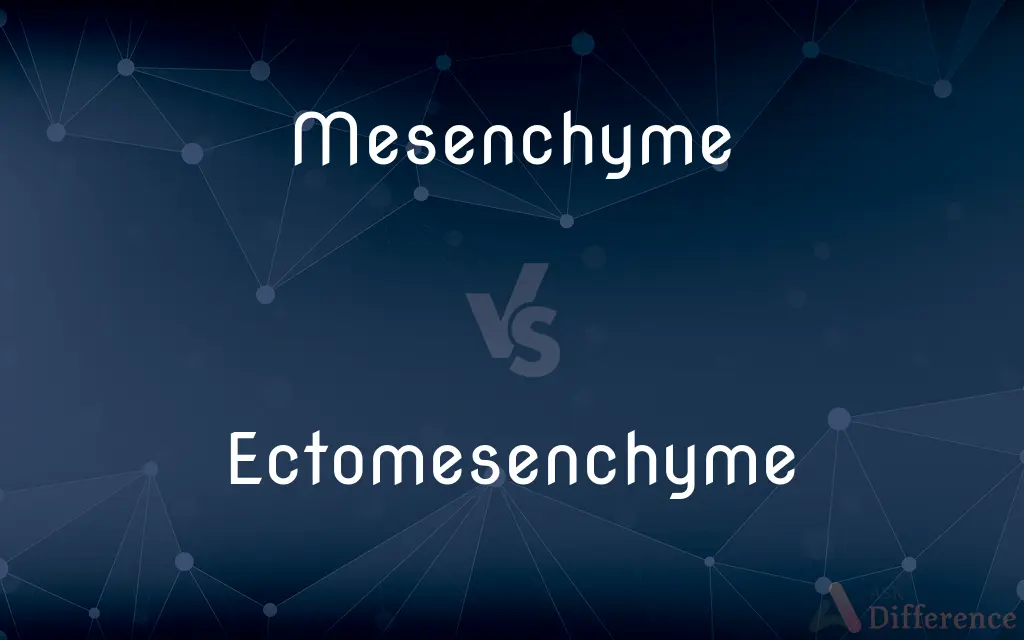Mesenchyme vs. Ectomesenchyme — What's the Difference?
By Fiza Rafique & Urooj Arif — Updated on April 8, 2024
Mesenchyme originates from the mesoderm, forming connective tissues, while ectomesenchyme derives from the neural crest, contributing to facial structures.

Difference Between Mesenchyme and Ectomesenchyme
Table of Contents
ADVERTISEMENT
Key Differences
Mesenchyme is a type of embryonic connective tissue originating from the mesoderm layer, which plays a crucial role in the development of the musculoskeletal, circulatory, and lymphatic systems. On the other hand, ectomesenchyme, also known as neural crest-derived mesenchyme, arises from the neural crest cells, a group of cells that form along the dorsal edges of the neural tube and contribute mainly to the development of facial cartilage, dentin, and certain types of nerve tissue.
While mesenchyme cells are primarily involved in giving rise to structures such as bones, muscles, and the heart, ectomesenchyme cells differentiate into a variety of cell types, including those forming the craniofacial structures, some types of neurons, and Schwann cells. This distinction underlines the diverse developmental pathways and outcomes of these two types of embryonic tissues.
Mesenchyme is characterized by its ability to transform into a wide range of connective tissues through a process known as mesenchymal transition. This is essential for the healing and regeneration of tissues in the body. Ectomesenchyme, conversely, is pivotal in the development of the peripheral nervous system and the craniofacial skeleton, indicating a specialization in forming structures that are crucial for sensory functions and facial aesthetics.
The origin of mesenchyme cells from the mesoderm layer of the embryo highlights their role in forming not only connective tissues but also contributing to the development of the vascular and lymphatic systems. Ectomesenchyme's origin from the neural crest emphasizes its contribution to the development of neural structures and the peripheral nervous system, showcasing the intricate relationship between the nervous system and structural development.
Despite their different origins and primary functions, both mesenchyme and ectomesenchyme share the capability to migrate and differentiate into various cell types, demonstrating the plasticity and essential role of embryonic tissues in development. Their differentiation into a broad spectrum of cell types illustrates the complexity of embryonic development and the specialized functions these tissues perform in forming the vertebrate body.
ADVERTISEMENT
Comparison Chart
Origin
Mesoderm layer of the embryo
Neural crest cells
Main Functions
Formation of connective tissues, muscles, vascular and lymphatic systems
Development of facial structures, certain neurons, and Schwann cells
Cell Types
Osteoblasts, chondrocytes, myocytes, and endothelial cells
Craniofacial cartilage, dentin-producing cells, and peripheral neurons
Contribution to Embryonic Development
Structural support, formation of the musculoskeletal system
Craniofacial development, sensory functions
Regenerative Capability
High in connective tissues
Specific to craniofacial structures and peripheral nervous system
Compare with Definitions
Mesenchyme
Forms musculoskeletal structures.
Mesenchyme cells differentiate into bone and muscle cells.
Ectomesenchyme
Contributes to facial development.
Ectomesenchyme cells form the facial bones and cartilage.
Mesenchyme
Involved in healing and regeneration.
Mesenchyme plays a key role in tissue repair processes.
Ectomesenchyme
Differentiates into dentin-producing cells.
Ectomesenchyme is essential for the development of teeth.
Mesenchyme
Contributes to vascular development.
Mesenchyme cells can develop into the cells forming blood vessels.
Ectomesenchyme
Forms parts of the peripheral nervous system.
Some ectomesenchyme cells become peripheral neurons.
Mesenchyme
Derived from the mesoderm.
During embryonic development, mesenchyme originates from the mesoderm.
Ectomesenchyme
Specializes in craniofacial structures.
Ectomesenchyme's differentiation is crucial for facial aesthetics.
Mesenchyme
Embryonic connective tissue.
Mesenchyme forms the basis for the body's connective tissue system.
Ectomesenchyme
Neural crest-derived tissue.
Ectomesenchyme originates from cells of the neural crest.
Mesenchyme
The part of the embryonic mesoderm, consisting of loosely packed, unspecialized cells set in a gelatinous ground substance, from which connective tissue, bone, cartilage, and the circulatory and lymphatic systems develop.
Ectomesenchyme
Ectomesenchyme has properties similar to mesenchyme. The origin of the ectomesenchyme is disputed.
Ectomesenchyme
(anatomy) A form of mesenchyme, in the embryo, consisting of neural crest cells; forms the tissues of the neck and cranium
Common Curiosities
Can mesenchyme cells differentiate into various cell types?
Yes, mesenchyme cells can differentiate into a wide range of cell types, including those forming bones, muscles, and blood vessels.
What is ectomesenchyme?
Ectomesenchyme is embryonic tissue derived from the neural crest, involved in developing facial structures, certain types of neurons, and Schwann cells.
What is mesenchyme?
Mesenchyme is an embryonic connective tissue that originates from the mesoderm, playing a crucial role in forming the body's musculoskeletal, circulatory, and lymphatic systems.
How do mesenchyme and ectomesenchyme differ in origin?
Mesenchyme originates from the mesoderm layer of the embryo, whereas ectomesenchyme comes from neural crest cells.
Why is mesenchyme important for embryonic development?
Mesenchyme is essential for embryonic development because it forms the basis for the musculoskeletal, vascular, and lymphatic systems.
What structures does ectomesenchyme contribute to?
Ectomesenchyme contributes to the development of facial cartilage, dentin, and certain peripheral nervous system components.
How does mesenchyme contribute to tissue healing?
Mesenchyme contributes to tissue healing through its ability to differentiate and regenerate various connective tissues.
How do mesenchyme and ectomesenchyme contribute to the development of the heart?
Mesenchyme plays a direct role in forming the heart by contributing to the cardiac muscle and connective tissue, while ectomesenchyme does not directly contribute to heart development.
What makes ectomesenchyme unique in craniofacial development?
Ectomesenchyme is unique in craniofacial development due to its specialization in forming facial bones, cartilage, and dentin.
Are mesenchyme and ectomesenchyme found in adults?
While their direct forms are embryonic, the cells derived from mesenchyme and ectomesenchyme contribute to adult tissues and functions, especially in healing and regeneration.
Can ectomesenchyme cells form skeletal tissue?
Ectomesenchyme cells primarily contribute to craniofacial skeletal tissues, unlike mesenchyme, which can form broader skeletal structures.
What is the significance of mesenchymal transition in healing?
Mesenchymal transition is significant in healing as it allows cells to migrate and transform into necessary connective tissue cells for repair.
What role does ectomesenchyme play in the peripheral nervous system?
Ectomesenchyme plays a role in developing the peripheral nervous system by differentiating into certain types of neurons and Schwann cells.
What is the difference in regenerative capabilities between mesenchyme and ectomesenchyme?
Mesenchyme has broad regenerative capabilities across various tissues, while ectomesenchyme's regenerative capacity is more specialized towards craniofacial structures and the peripheral nervous system.
How does the origin from neural crest cells affect ectomesenchyme?
Originating from neural crest cells gives ectomesenchyme the capacity to contribute uniquely to facial aesthetics and the peripheral nervous system.
Share Your Discovery

Previous Comparison
Lustre vs. Matte
Next Comparison
Holoprotein vs. ApoproteinAuthor Spotlight
Written by
Fiza RafiqueFiza Rafique is a skilled content writer at AskDifference.com, where she meticulously refines and enhances written pieces. Drawing from her vast editorial expertise, Fiza ensures clarity, accuracy, and precision in every article. Passionate about language, she continually seeks to elevate the quality of content for readers worldwide.
Co-written by
Urooj ArifUrooj is a skilled content writer at Ask Difference, known for her exceptional ability to simplify complex topics into engaging and informative content. With a passion for research and a flair for clear, concise writing, she consistently delivers articles that resonate with our diverse audience.













































